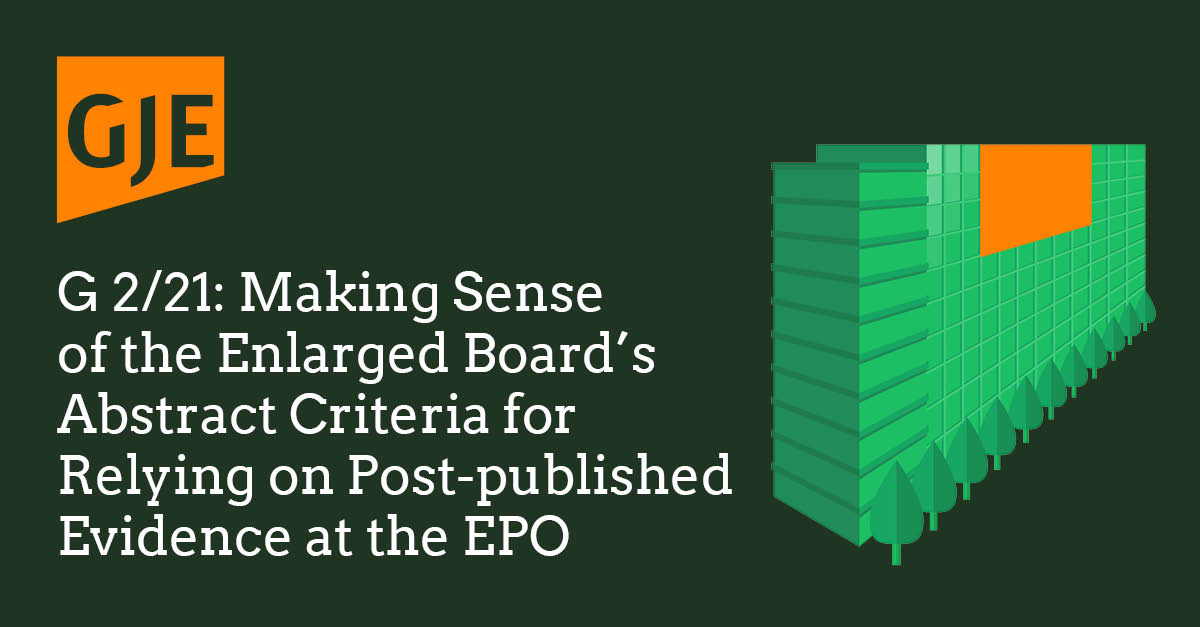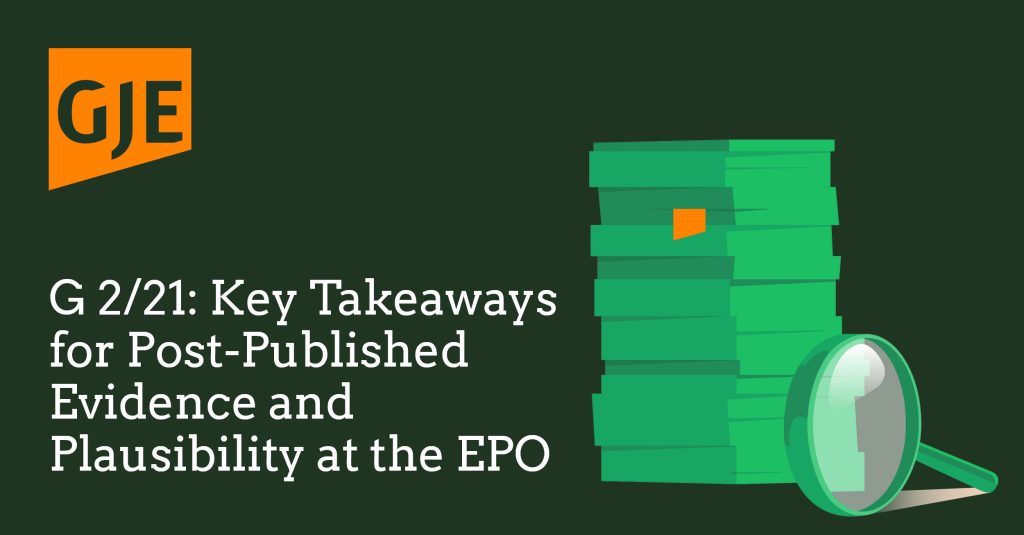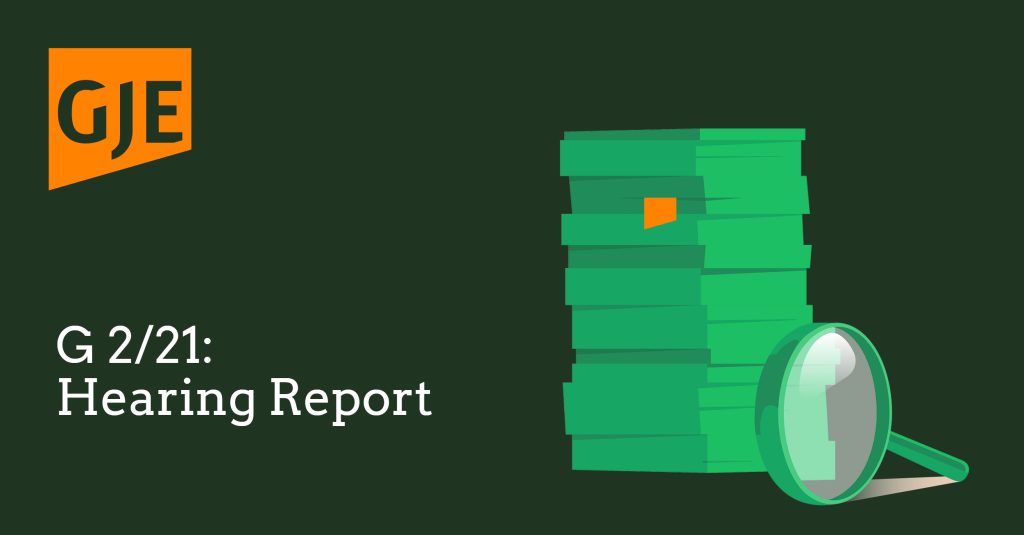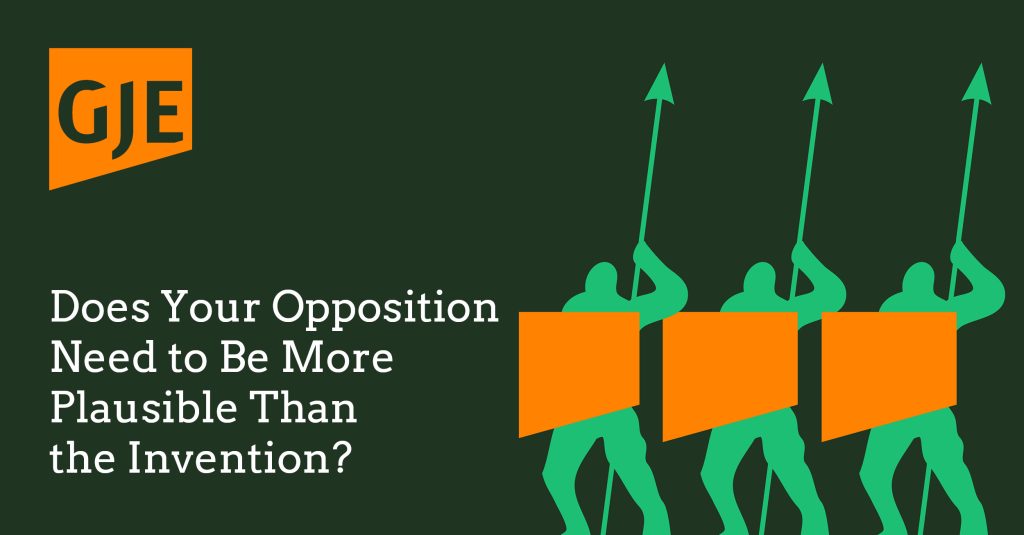
As reported in our key takeaways summary on 23 March 2023, the Enlarged Board of Appeal has handed down its eagerly anticipated G 2/21 decision concerning whether post-published evidence can be used to prove the existence of a technical effect in the assessment of inventive step.
This article explores the guiding principles set out in the decision and seeks to interpret how they may be applied in practice.
The objective of the Enlarged Board
The main task of the Enlarged Board was to clarify the role of plausibility in the determination of whether post-published evidence can be used in the assessment of inventive step and so ensure the uniform application of the law.
As a re-cap, the questions referred to the Enlarged Board were:
- Should an exception to the principle of free evaluation of evidence (see e.g. G 3/97, Reasons 5, and G 1/12, Reasons 31) be accepted in that post-published evidence must be disregarded on the ground that the proof of the effect rests exclusively on the post-published evidence?
- If the answer is yes (the post-published evidence must be disregarded if the proof of the effect rests exclusively on this evidence), can the post-published evidence be taken into consideration if, based on the information in the patent application in suit or the common general knowledge, the skilled person at the filing date of the patent application in suit would have considered the effect plausible (ab initio plausibility)?
- If the answer to the first question is yes (the post-published evidence must be disregarded if the proof of the effect rests exclusively on this evidence), can the post-published evidence be taken into consideration if, based on the information in the patent application in suit or the common general knowledge, the skilled person at the filing date of the patent application in suit would have seen no reason to consider the effect implausible (ab initio implausibility)?
What did the Enlarged Board decide?
Although the Enlarged Board confirmed that post-published evidence can in principle be used, the decision does not clarify the law regarding the circumstances in which post-published evidence can be used to support an inventive step.
To the disappointment of many stakeholders, the Enlarged Board refrained from endorsing or dismissing either the ab initio plausibility standard or the ab initio implausibility standard. Rather, the Enlarged Board considered that “plausibility” does not amount to a distinctive legal concept or a specific patent law requirement under the EPC. Further, the Enlarged Board seemingly dismissed the notion that there were diverging lines of case law and instead suggested there was common ground between the differing decisions.
Based on this common ground the Enlarged Board provided “guiding principles” for the deciding bodies of the EPO when taking a decision on whether post-published evidence may be relied upon in support of an asserted technical effect when assessing whether the claimed subject matter involves an inventive step:
- A patent applicant or proprietor may rely upon a technical effect for inventive step if the skilled person, having the common general knowledge in mind, and based on the application as originally filed, would derive (consider) said effect as being encompassed by the technical teaching and embodied by the same originally disclosed invention.
The Enlarged Board acknowledged the “abstractness” of these criteria, so the Enlarged Board must be aware that it has not clarified the circumstances in which post-published evidence can be used to support an inventive step.
Further, it appears that ab initio plausibility and ab initio implausibility arguments may remain persuasive under the new guiding principles, because the Enlarged Board was apparently satisfied that the outcome in each particular case (referring to cases applying either the ab initio plausibility or ab initio implausibility standard) would not have been different from the actual finding of the respective board of appeal had the guiding principles been applied.
A final snag is that the Enlarged Board arguably endorsed the ab initio plausibility standard with respect to the assessment of sufficiency of disclosure. This sits awkwardly with the Enlarged Board’s suggestion that applying the guiding principles would not have affected the outcome in previous cases that applied the ab initio implausibility standard, given that some of those decisions confirmed the respective inventions were sufficiently disclosed.
Where does this leave us?
As expected, the decision confirms that post-published evidence can be submitted to support an inventive step. Important factors not mentioned in the decision are that the post-published evidence must be submitted on time and be relevant to the case to be taken into account by the deciding body. It is also established law that the technical effect supported by the post-published evidence must be derivable from the application as filed. This includes technical effects not explicitly mentioned in the application, if they are implied by or related to the problem suggested in the application.
The relevant standard for reliance on a technical effect for inventive step is whether the skilled person would consider the effect as being encompassed by the technical teaching of the original application and embodied by the originally disclosed invention.
While the decision does not dismiss the ab initio implausibility standard, it must be assumed that the standard of ab initio plausibility – widely seen as a higher threshold – can still be applied. Applicants and proprietors should therefore draft, prosecute and defend accordingly.
Decisions will be taken on a case-by-case basis and the Enlarged Board acknowledged that the outcome is likely to be influenced by the technical field of the invention.
Our attempt to make sense of the guiding principles is as follows.
The EPO wants applicants and proprietors to engage with the “problem and solution approach” applied by the deciding bodies. The problem and solution approach requires that technical effects are causally related to the difference between the claimed invention and the prior art. This necessarily means that the technical effect in the context of the problem and solution approach may be different from the technical effect originally put forward in the application.
It is therefore helpful to conceptually distinguish between the technical effect originally put forward in the application (the “original” technical effect) and a “new” technical effect invoked in view of the prior art.
Whether the “original” technical effect is encompassed by the technical teaching of the original application and embodied by the originally disclosed invention requires the application and the common general knowledge to make it probable that the effect is achieved. This depends on the technical field of the invention. For some inventions it is unnecessary to provide data in the application because an explanation in the application is sufficient evidence to make it probable that an effect will be achieved. On the other hand, there are technical fields in which data in the application will normally be necessary. For example, it is generally improbable that a new compound will modulate the activity of a target because most compounds would not, so data is needed as evidence to show that the claimed compound has the desired activity. To put it another way, the skilled person must not doubt that the effect is achieved, based on the application and their common general knowledge. The threshold is the same for all inventions, but the required evidence depends on the facts.
If it is decided that the evidence in the application does not make it probable that the original technical effect is achieved, then the original technical effect would not be encompassed by the technical teaching of the original application and embodied by the originally disclosed invention. It is unlikely that post-published evidence could change this. Further, absent an original technical effect being encompassed by the technical teaching of the original application and embodied by the originally disclosed invention, it is unlikely that post-published evidence supporting a new technical effect would be taken into account.
On the other hand, if the application and common general knowledge contain evidence that makes it probable that the original effect is achieved, and a new technical effect is relied upon in view of the prior art, there is greater scope to rely upon post-published evidence to support the new effect.
In the above example of a new compound, prior art may be identified that discloses structurally similar compounds having similar activity to those claimed. If the applicant provided post-published evidence demonstrating that the claimed compounds provide reduced toxicity, then it is conceivable that reduced toxicity is encompassed by the technical teaching of the original application and embodied by the same originally disclosed invention.
Next steps
The decision G 2/21 does not provide the desired clarity on when it is permissible to rely on post-published data to support inventive step. Thus, the circumstances under which post-published evidence may be relied on to support inventive step will continue to be a contentious area.
Please contact Ash Earl or Arnie Clarke or any of your usual GJE contacts if you would like to discuss the potential relevance of G 2/21 to your business.
This article was also published by Lexis®PSL and can be viewed on their platform here.


